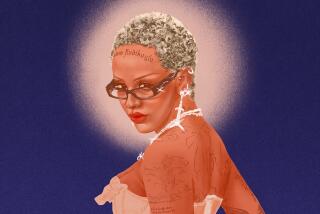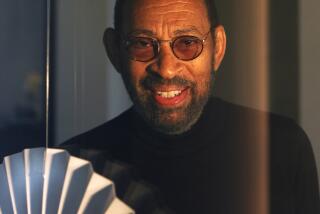Don’t Underestimate Women’s Role in Tap
- Share via
In response to “Bring in ‘Da Noise, Bring in ‘Da Funk” star Derick K. Grant’s remarks about tap-dancing (“ ‘Noise’s’ Heir Apparent,” Calendar, March 17), surely he is being elitist, not to say sexist, when he puts down female tap-dancers so strongly (“You have to take tap as seriously as I do to share the stage with me. . . . And there are some women who
are like that but not the majority.”)
And also condescending. (“You don’t see many men teaching. The only way we are getting our education is through women.”)
What is this? A tap twist on the line, “Those who can, do. Those who can’t, teach”?
Wake up, Mr. Grant.
Remember what they said about Fred Astaire’s partners? That they could do everything that Fred could do--backward, and in high heels!
Women have played an important part in the evolution of tap. The minstrel shows and early vaudeville (both black and white versions) had their share of female performers. Among the early black and female pioneers of tap were the Whitman Sisters, who owned their own show, traveled all over the U.S. and were popular from around 1900 to 1943. Jazz dance historians Marshall and Jean Stearns call the Whitman Sisters “by far the greatest incubator of dancing talent for Negro shows.” Alice Whitman, with a decade and a half of stardom, was noted for “clean, clear taps like Bill [Bojangles] Robinson.”
Another early performer, Louise Madison, could “cut a five-tap Wing like a man.”
*
Broadway and Hollywood embraced both standard and innovative white tap females: Eleanor Powell, Ann Miller, Ruby Keeler, Dixie Dunbar, Eleanor Whitney. Their tap skills were equal to anybody’s. That is to say, the guys’.
Black female tappers were not so fortunate in the movies (to do with racial attitude more than talent) as the black male dancers. This may go some way to explaining the gender bias that exists even in today’s tap dance shows.
But to love tap--to be, in Grant’s words, “serious” about it--doesn’t mean you have to be male. Little girls in dance classes follow their dreams and aspirations with the same allegiance and dedication as little boys.
I’d also challenge Grant about his statement that women, rather than men, teach tap. My impression, after a couple of decades of choreography, is that most of the great teachers are guys. Louis Dapron, Pat Rico, Al Gilbert, Paul Kennedy, Honi Coles, Cholly Atkins, Henry LeTang, for example. The Hoofers Clubs in Harlem were, as Gregory Hines will tell you, the great teaching environments for ambitious tappers, and, by and large, these were exclusively male.
By all means let’s bring in ‘da noise, bring in ‘da funk, but let’s not bring in some outmoded ideas about the role and place of women in tap dance along with it.
*
Anita Mann is an Emmy Award-winning choreographer, producer and director who (as choreographer on “The Muppets”) taught Miss Piggy to tap. She is currently producing “Tap Girls,” a female tap dance show that is, in part, a response to male-dominated tap dance shows such as “Tap Dogs” and “Noise/Funk.” She is president of Anita Mann Productions in Santa Monica.
More to Read
Sign up for The Wild
We’ll help you find the best places to hike, bike and run, as well as the perfect silent spots for meditation and yoga.
You may occasionally receive promotional content from the Los Angeles Times.






